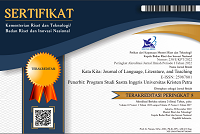Kim Namjoon’s Speech at the 2018 United Nations General Assembly: The Intentions and Impacts
(1) Petra Christian University
(*) Corresponding Author
Abstract
Keywords
Full Text:
PDFReferences
All the latest cyberbullying statistics 2022. (n.d.). BroadbandSearch.net. https://www.broadbandsearch.net/blog/cyber-bullying-statistics
Britannica Dictionary. (n.d.). Audience definition & meaning. Retrieved January 2, 2023, from https://www.britannica.com/dictionary/audience
BTS dan bagaimana idola membantu kesehatan mental. (2022, August 5). https://magdalene.co/story/bts-dan- bagaimana-idola-membantu-kesehatan-mental
Carter, R., & McCarthy, M. (2006). Cambridge grammar of english: A comprehensive guide to spoken and written english usage. Cambridge University Press.
https://www.amazon.com/s?k=Cambridge+Grammar+of+English%3A+A+Comprehensive+Guide.+Spoken+and+Written+English+Grammar+and+Usage&i=stripbooks
Cha, E. (2018, September 25). UNICEF explains why they invited BTS to speak at the United Nations. https://www.soompi.com/article/1235871wpp/unicef-explains-invited-bts-speak-united-nations
Creswell, J. W. (2014). Research design: qualitative, quantitative, and mixed methods approaches (4th edition). SAGE Publications.
Dalimunthe, N. (2020). Speech acts analysis of president Joko Widodo’s speech about COVID-19. [Bachelor’s Thesis, Muhammadiyah University of North Sumatra]. UMSU Repository.
Haye, A., & Larrain, A. (2011, March). What is an utterance?.
Kaburise, P. (2011). Speech act theory and communication: a univen study (1st edition.). Cambridge Scholars Publishing.
Kusumastuti, A., & Khoiron, A. M. (2019). Metode penelitian kualitatif. Lembaga Pendidikan Sukarno Pressindo.
Montti, R. (2022, September 3). What is Quora & how it works. https://www.searchenginejournal.com/what-is-quora-why-should-you-care/379341/
O’Keeffe, A., Clancy, B., Adolphs, S. (2011). Introducing pragmatics in use (2nd edition). Routledge Taylor & Francis Group.
Oxford Dictionary (n.d). Extrapolation.
https://www.oxfordlearnersdictionaries.com/definition/english/extrapolation?q=extrapolation
Paltridge, B. (2006). Discourse analysis. British Library cataloging-in-publication data, New York.
Umar, T. F. (2016). The analysis of speech act of president Joko Widodo at APEC forum. [Bachelor’s Thesis, Alauddin State Islamic University Makassar]. UIN-Alauddin Repository.
"We have learned to love ourselves, so now I urge you to “speak
yourself.””. (n.d.). https://www.unicef.org/press-releases/we-have-learned-love-ourselves-so-now-i-urge-you-speak-yourself
Wang, A. B. (2018). What the world's youths might learn from BTS, the K-pop stars who spoke at the U.N. https://www.washingtonpost.com/world/2018/09/25/what-worlds-youths-might-learn -bts-k-pop-stars-who-spoke-un/
Yule, G. (1996). Pragmatics. Oxford University Press.
DOI: https://doi.org/10.9744/katakita.11.2.255-267
Refbacks
- There are currently no refbacks.
Supported by:
Indexed in:
Tools:
Stats (installed since 17 December 2018)
View My Stats













